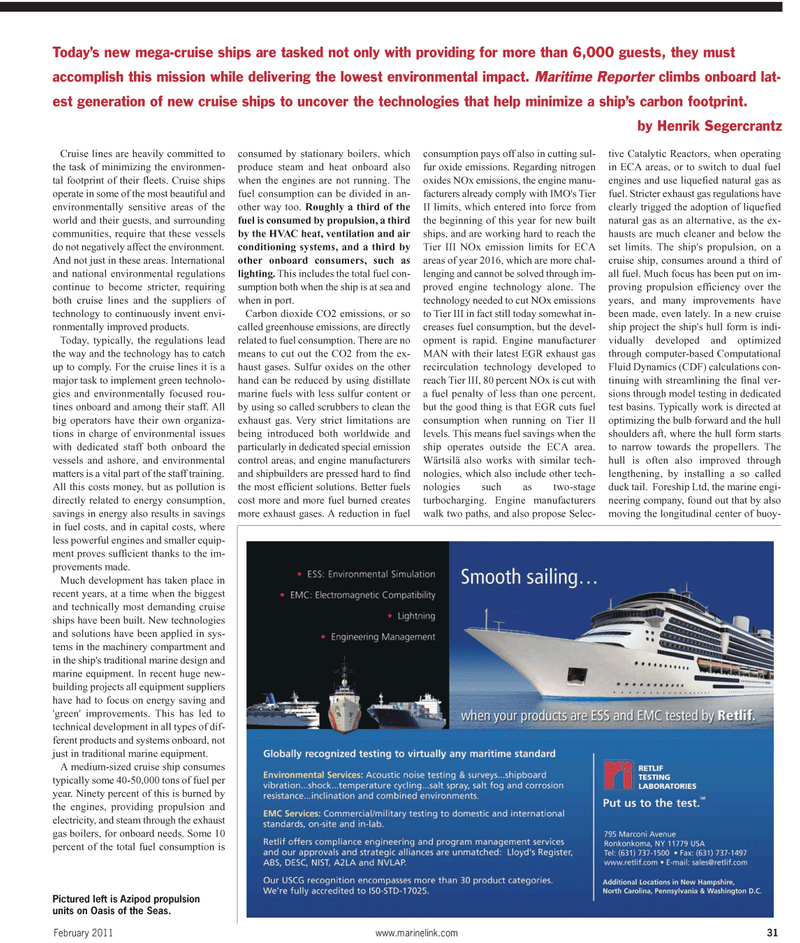
Page 31: of Maritime Reporter Magazine (February 2011)
Cruise & Passenger Vessel Annual
Read this page in Pdf, Flash or Html5 edition of February 2011 Maritime Reporter Magazine
February 2011 www.marinelink.com 31
Cruise lines are heavily committed to the task of minimizing the environmen- tal footprint of their fleets. Cruise ships operate in some of the most beautiful and environmentally sensitive areas of the world and their guests, and surrounding communities, require that these vessels do not negatively affect the environment.
And not just in these areas. International and national environmental regulations continue to become stricter, requiring both cruise lines and the suppliers of technology to continuously invent envi- ronmentally improved products.
Today, typically, the regulations lead the way and the technology has to catch up to comply. For the cruise lines it is a major task to implement green technolo- gies and environmentally focused rou- tines onboard and among their staff. All big operators have their own organiza- tions in charge of environmental issues with dedicated staff both onboard the vessels and ashore, and environmental matters is a vital part of the staff training.
All this costs money, but as pollution is directly related to energy consumption, savings in energy also results in savings in fuel costs, and in capital costs, where less powerful engines and smaller equip- ment proves sufficient thanks to the im- provements made.
Much development has taken place in recent years, at a time when the biggest and technically most demanding cruise ships have been built. New technologies and solutions have been applied in sys- tems in the machinery compartment and in the ship's traditional marine design and marine equipment. In recent huge new- building projects all equipment suppliers have had to focus on energy saving and 'green' improvements. This has led to technical development in all types of dif- ferent products and systems onboard, not just in traditional marine equipment.
A medium-sized cruise ship consumes typically some 40-50,000 tons of fuel per year. Ninety percent of this is burned by the engines, providing propulsion and electricity, and steam through the exhaust gas boilers, for onboard needs. Some 10 percent of the total fuel consumption is consumed by stationary boilers, which produce steam and heat onboard also when the engines are not running. The fuel consumption can be divided in an- other way too. Roughly a third of the fuel is consumed by propulsion, a third by the HVAC heat, ventilation and air conditioning systems, and a third by other onboard consumers, such as lighting. This includes the total fuel con- sumption both when the ship is at sea and when in port.
Carbon dioxide CO2 emissions, or so called greenhouse emissions, are directly related to fuel consumption. There are no means to cut out the CO2 from the ex- haust gases. Sulfur oxides on the other hand can be reduced by using distillate marine fuels with less sulfur content or by using so called scrubbers to clean the exhaust gas. Very strict limitations are being introduced both worldwide and particularly in dedicated special emission control areas, and engine manufacturers and shipbuilders are pressed hard to find the most efficient solutions. Better fuels cost more and more fuel burned creates more exhaust gases. A reduction in fuel consumption pays off also in cutting sul- fur oxide emissions. Regarding nitrogen oxides NOx emissions, the engine manu- facturers already comply with IMO's Tier
II limits, which entered into force from the beginning of this year for new built ships, and are working hard to reach the
Tier III NOx emission limits for ECA areas of year 2016, which are more chal- lenging and cannot be solved through im- proved engine technology alone. The technology needed to cut NOx emissions to Tier III in fact still today somewhat in- creases fuel consumption, but the devel- opment is rapid. Engine manufacturer
MAN with their latest EGR exhaust gas recirculation technology developed to reach Tier III, 80 percent NOx is cut with a fuel penalty of less than one percent, but the good thing is that EGR cuts fuel consumption when running on Tier II levels. This means fuel savings when the ship operates outside the ECA area.
Wärtsilä also works with similar tech- nologies, which also include other tech- nologies such as two-stage turbocharging. Engine manufacturers walk two paths, and also propose Selec- tive Catalytic Reactors, when operating in ECA areas, or to switch to dual fuel engines and use liquefied natural gas as fuel. Stricter exhaust gas regulations have clearly trigged the adoption of liquefied natural gas as an alternative, as the ex- hausts are much cleaner and below the set limits. The ship's propulsion, on a cruise ship, consumes around a third of all fuel. Much focus has been put on im- proving propulsion efficiency over the years, and many improvements have been made, even lately. In a new cruise ship project the ship's hull form is indi- vidually developed and optimized through computer-based Computational
Fluid Dynamics (CDF) calculations con- tinuing with streamlining the final ver- sions through model testing in dedicated test basins. Typically work is directed at optimizing the bulb forward and the hull shoulders aft, where the hull form starts to narrow towards the propellers. The hull is often also improved through lengthening, by installing a so called duck tail. Foreship Ltd, the marine engi- neering company, found out that by also moving the longitudinal center of buoy-
Today’s new mega-cruise ships are tasked not only with providing for more than 6,000 guests, they must accomplish this mission while delivering the lowest environmental impact. Maritime Reporter climbs onboard lat- est generation of new cruise ships to uncover the technologies that help minimize a ship’s carbon footprint. by Henrik Segercrantz
Pictured left is Azipod propulsion units on Oasis of the Seas.

 30
30

 32
32
